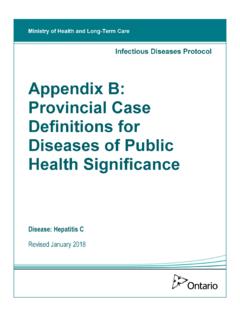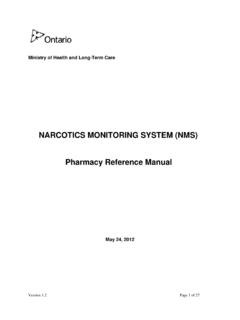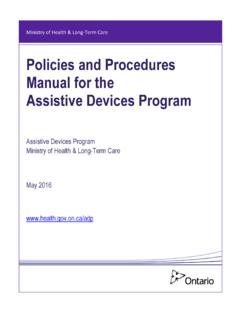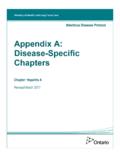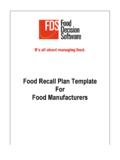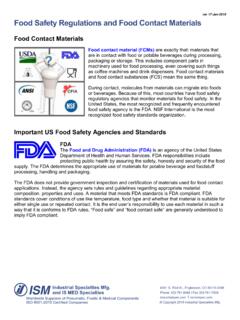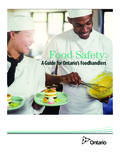Transcription of Food Safety: A Guide for Ontario's Food Handlers
1 food Safety: A Guide for ontario s Foodhandlers2 Acknowledgment The content of this document has been reproduced by the Ministry of Health and Long-Term Care with the permission of the Windsor-Essex County Health Unit. The ministry would like to thank the Windsor-Essex County Health Unit for this valuable contribution towards the development of a provincial training program. This document is available, in whole or in part, for the use of public health units in ontario . The ministry takes no responsibility for any modification of the content of this document.
2 Ministry of Health and Long-Term Care Public Health Division, updated January, 20173 Table of Contents 4 Introduction 12 Foodborne Illness 26 Microorganisms 43 Time and Temperature 58 Receiving and Storage 69 Microbiological Contamination 78 Personal Hygiene 89 Cleaning and Sanitizing 104 Pest Control 114 food Safety Management 124 References 125 Appendices4 Introduction 5 Introduction to food Safety 6 Benefits for food Premises 6 food Safety Legislation 10 Responsibilities 11In ReviewINTRODUCTION5 Introduction to food Safety The food service industry is a big part of the canadian economy.
3 It includes people working in the many different parts of food service, like restaurants and grocery stores, and factories that process, package and ship food to those restaurants and stores. A food premise is a place that prepares and/or sells food . It s well known that there s a need for special standards in the food industry because of: The chance for the spread of disease and illness through food Customers wanting to be sure the places they buy their food from are safe The first goal of any food premise must be to produce the safest and highest quality food possible.
4 Unfortunately, many of the people working in food premises don t fully understand the risks involved in food service or the need to meet food safety requirements, like personal hygiene, avoiding food contamination and keeping foods at safe temperatures. This course will teach you how to keep food Benefits for food Premises A well designed food safety program is good for both the food premises and their customers. Repeat business from customers and higher job satisfaction for employees can lead to higher profits and better service. Some ways that food premises can benefit are.
5 More repeat business from customers who will want to keep going to a place where the food is safe Employees being happier with their jobs knowing that the food they are working with is safe Lower insurance costs because no claims have been made against their insurance from unsafe food Not having to spend money on lawsuits, medical claims or fines for having unsafe food Happier customers because handling food safely helps to keep it fresher and better tasting Cleaning and sanitizing costs can be kept down if food premises are kept safe Not wasting money by throwing away food that was not kept safe Not losing money by having to close because of unsafe conditions Not having the bad publicity, and loss of customers.
6 That can happen if food premises are closed by the health unit food Safety Legislation The food service industry is regulated by legislation at all three levels of government (federal, provincial and municipal). Legislation is the set of rules that food premises need to follow to make sure their food is kept safe. Some of it is specific to the food , like cooking temperatures. Other rules cover things like the condition of the building and the types of equipment that need to be used. All of these things together are very important, and have an impact on how safe your food is.
7 It is the responsibility of everyone working in food premises to make sure they know the rules that apply to them and to follow those rules. Federal The canadian food inspection agency (CFIA) was created in April 1997. It s made up of food inspectors from Health Canada, Agriculture and Agri- food , and the Department of Fisheries and Oceans. CFIA is responsible for the inspection of food at the federal The main regulating legislation at the federal level is the food and Drugs Act. The food and Drugs Act (and accompanying regulations) sets standards for all foods produced and sold in Canada.
8 It looks at things such as the alteration, colouring, bacterial standards, manufacturing conditions and distribution of food to ensure the safety of human health. There are also other acts and regulations at the federal level that govern specific food types like meats, milk and dairy, fish and seafood, poultry and eggs. These foods need special attention because they ve been linked to outbreaks of foodborne illnesses. You ll learn more about this in later chapters. Provincial - Health Protection and Promotion Act (HPPA) Each province has its own provincial health acts and regulations.
9 In ontario , the Health Protection and Promotion Act, 1990 (HPPA) lays out the mandate to make regulations, programs and protocols which govern food premises. All health units/departments are responsible for the conditions and safety under which food is held, prepared and served to the public. This is also the responsibility of the food premises owner/operator and employees. The HPPA lays out the powers of the medical officer of health and the public health inspector. Some of these are: Power of Entry - HPPA (S. 41) The medical officer of health or a public health inspector may enter any place of business, during normal work hours, without a warrant, to carry out the duties under the act.
10 This would include routine inspections or the investigation of complaints of health hazards. Power of Seizure - HPPA (S. 19) The medical officer of health or a public health inspector may seize anything suspected of being a health hazard for laboratory testing. Power of Destruction - HPPA (S. 19) If a public health inspector determines that food is a health hazard, he/she has the power to destroy or dispose of the food immediately. Power to Make an Order - HPPA (S. 13) Orders are issued to eliminate a health hazard, or to lessen the effects of a health hazard.
